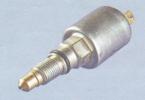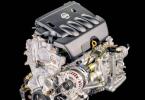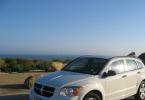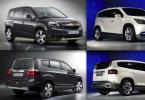We usually put a group test around a brand new model and frame it with a few classmates. It is extremely rare that a restyled car is the instigator - only if it is a sales star.
Today, the star is Nissan Qashqai, which sold 23 192 units last year, entered the top 25 of the Russian market and took a leading position in its segment.
The design hasn't changed much. - Mitsubishi ASX and Suzuki SX4 with four-wheel drive and engines of comparable power will help us to test it for strength.
| Mitsubishi ASX He made his debut in 2010. During this time, he was repeatedly. The last restyling dates back to March; the updated version will reach Russia closer to winter. Made in Japan. ENGINES: | Suzuki SX4 The second generation crossover was presented in 2013 (at first it was sold under the name New SX4 - at the same time as its predecessor). Published since 2016. Made in Hungary. ENGINES: | Nissan Qashqai The second generation was shown in 2013, but Russian sales began only in 2014. They appeared this winter - with a refreshed design, new equipment and chassis settings. Diesel was removed from the range of engines. Made in Russia. ENGINES: |
Camera ahead!
When the Nissan people had just started to install, we did not advise paying extra for it - the system was incompatible with a rear-view camera. Last spring, programmers removed this issue, and there is no need to sacrifice a video prompter anymore. Victory? Well, how to say ... The camera turns on with a five-second delay, and this can bring even a Buddhist monk to white heat. And loading after starting the engine lasts unreasonably long - seven to eight seconds.
Otherwise, Yandex.Navigator is good. He confidently leads the route, taking into account traffic jams, shows the real speed and warns about cameras. And there is also access to online stations and weather forecasts. But the price still bites - 54,000 rubles. I would spend this money on other utilities.
Unlike opponents, Nissan can be equipped with LED headlights with automatic switching from high beam to low beam, blind spot and lane monitoring, self-parking, all-round visibility system. And you can refuse this "pampering" and choose (we are talking about an all-wheel drive modification with a variator).
| | | |
The interior of Kashkai makes a very pleasant impression. The music tracks sound surprisingly decent. The most comfortable front seats in the test trio and a chic (by the standards of the segment, of course) rear row with two USB connectors for charging gadgets and deflectors at the end of the central tunnel. Plus heated windscreen, steering wheel and rear seat inaccessible to rivals. There are obvious shortcomings - a Logan's ceiling in the ceiling and the lack of a platform for a smartphone.
The SX4 is greeted with a very unpretentious finish. Hard stone window sills are in no way associated with the price of 1,709,000 rubles. Glare bezels around the tidy scales and a tiny monochrome display between them are puzzling. As well as the whitish picture from the rear view camera.
| | | |
You can still accept this, but not with the front seats. They have push-out backs and the lumbar support is not adjustable.
There were no other questions about ergonomics. The mutual arrangement of the steering wheel, pedals and the machine selector is verified, I liked the friendly and intuitive interface of the multimedia system.
The ASX's cabin tries to look youthful with gleaming metal pedals and massive paddle shifters - but these embellishments can't hide its age. The ASX has a specific, high seating position and an unreasonably short variator selector (you have to drag on). The seats are upholstered in leather and electrically adjustable, but better lateral support instead of a hint of it would have been better. And there is also a lot of plastic of different textures - however, of high quality.
| | | |
The antediluvian media center lacks a regular navigator, Apple CarPlay and Android Auto support, and is not even Russified. Inexplicable puncture.
ASX cannot win back even with the second row: knees support the backs of the front seats, the ceiling is low. "I have become part of the supporting structure!" - joked our 190-centimeter tester. The situation is aggravated by the uncomfortable profile of the pillow. And there are no pockets in the door.
Judging by our measurements, the SX4 gallery should also be cramped, but you don't feel such a tightness. In addition, in Suzuki, you can change the angle of the backrest (however, there are only two positions). The greatest room for rear passengers is in Qashqai.
Is there power?
Studying the technical data, you can write off Suzuki in advance: it has the weakest engine - only 140 hp. But The SX4 rides away from the competition with mocking ease! At least from a place, at least on the move, he leaps forward and disappears from sight.
There are two explanations for this agility. First, turbocharging. It delivers solid torque (220 Nm) at a very wide rpm "shelf". Secondly, the SX4 is lighter than its rivals by at least 170 kg.
Suzuki gearbox - 6-speed hydromechanics. She changes gears quickly and predictably.
Nissan and Mitsubishi have naturally aspirated engines in tandem with variators. The power figures are close (144 and 150 hp), as well as the acceleration dynamics. But how differently these machines are perceived!
Qashqai picks up speed resiliently and predictably, its variator perfectly simulates quasi-gear shifting. Lightweight, relaxed character. And the Mitsubishi engine freezes at 6000 rpm, filling the cabin with such a howl that the right foot involuntarily releases the pedal. And without this, the ASX is noisier: the wind howls, there is a hum from the road.
Before the restyling, Qashqai was also not quiet, but thanks to additional mats on the bottom and engine shield, as well as a laminated windshield, the noise became less - about the level of the SX4.
And also Suzuki “overdid” everyone. The braking distances of Nissan and Mitsubishi are slightly longer. Kashkai has a perfectly tuned pedal drive, which allows mending deceleration with millimeter precision. The ASX has a late grip and takes some getting used to. But why, having laid out more than one and a half million, do you need to adapt to something?
Crunch of bones
I have always liked Qashqai, but I would not have bought it for myself - I absolutely did not like the smoothness of the ride. Driving even over symbolic irregularities was accompanied by an unpleasant shaking. but with recalibrated springs and shock absorbers, ride comfort is clearly improved. Even on the broken April asphalt - peace and quiet.
And you didn't have to sacrifice handling. The updated Qashqai rides more confidently than before - the increased diameter of the front anti-roll bar, as well as the new electric power steering software, thanks to which a completely sane feedback appeared at the steering wheel. A completely different car. And I like him!
But the ASX has not changed its character since the moment of our last meeting: the suspension, as it was shaking, remained. The machine crushes unpleasantly on a comb and gives in to irregularities with a larger caliber. And loudly crunches the knuckles of the pendants. Finally, the Mitsu is worse than the Nissan and the Suzuki keeps a straight line and slides off the trajectory earlier, frightening with deep rolls.
In terms of smoothness, the SX4 is between ASX and Qashqai. If the suspension confidently mixes small things, then every now and then it closes on the "large". But what a handling Suzuki has! Like a dachshund on the hunt, the SX4 pounces on corners with enthusiasm, demonstrating excellent grip.
Where do these light reactions come from? Look at the table again. Suzuki has the lowest body and lowest ground clearance. Off-road, the 145 mm clearance requires extremely careful driving. And what kind of impassability there is! A small rut - and a grinding sound is heard under the bottom. The suspension is short-travel, so the wheels are hung out at a time. On a dry surface, this is not so scary, since well-tuned electronics helps to get out of the diagonal "hanging".
- SX4 very dexterously controlled and confidently holds a straight line. The overclocking dynamics are much better than those of the competitors. This car is perceived by the driver as a passenger car, and not as a crossover.
- After modernization Qashqai became better to obey the steering wheel, added to the smoothness of the course. But the overclocking dynamics remained at the same average level.
- To accelerating dynamics ASX no complaints, but the soundtrack of the motor stuck at 6000 rpm is unpleasant.
It is not necessary to count points to understand who lost this test: lag ASX obviously. Ergonomics problems, a cramped rear row, meager equipment and modest ride comfort could have turned a blind eye at a low price, but the test ASX is only 36,000 rubles cheaper than the SX4, which took second place.
The ASX needs to be replaced with a new car for a long time, but instead, the Japanese have prepared only a restyled version, which will go on sale closer to winter. The L200-inspired look and modern multimedia are the main innovations. The technical stuffing is still the same.
Suzuki SX4- a lively car with pleasant handling, but with a ground clearance of 145 mm you won't go far.
Qashqai today is the best. Spacious, comfortable, decently equipped and perfectly adapted to Russian conditions. An excellent combination of price and quality determines its leadership in sales.
| | | |
Kar-index takes into account the operating costs for a mileage of 70,000 km: registration and inspection fees, transport tax, costs of compulsory motor third party liability insurance, fuel and scheduled maintenance, as well as losses during the resale of the car.
Detailed technical information about the heroes of our test, as well as the results of tests on a roller platform are available at.
EXPERT ASSESSMENT OF CARS
Points are put down collegially, by a group of ZR experts. The score is not absolute, it shows the place of the car in a given test against specific competitors. The maximum score is 10 points (ideal). 8 points is the norm for cars of this class.
| Model | MITSUBISHI ASX | NISSAN QASHQAI | SUZUKI SX4 |
| Driver's workplace | The most comfortable seat is in Qashqai. In the SX4, the push-out profile of the backrest interferes, and in the ASX the lateral support is too weak. There are no complaints about the ergonomics of Nissan and Suzuki, but we criticize Mitsubishi for too low a variator selector. The visibility in the SX4 is worse - the mirrors are too small. |
||
| 8 | 9 | 8 |
|
| Governing bodies | 8 | 9 | 9 |
| 8 | 8 | 7 |
|
| Salon | It is most convenient to get into Nissan: the doors open wide and the thresholds are always clean. In terms of equipment, the Qashqai is also ahead of its rivals, as well as in spaciousness in the second row. The tightest rear seats are in Mitsubishi. The SX4 is in the lead in luggage capacity. |
||
| front part | 8 | 9 | 8 |
| Rear part | 7 | 9 | 8 |
| Trunk | 8 | 8 | 9 |
| Driving performance | Accelerating dynamics is Suzuki's strong point. Thanks to the turbo engine, it easily breaks away from rivals. For brakes, the SX4 and Qashqai scored higher than the ASX, which was let down by the uninformative drive. In terms of handling, the leaders are again Suzuki, which drives at the level of a good-quality passenger car. |
||
| Dynamics | 8 | 8 | 9 |
| 8 | 9 | 9 |
|
| Controllability | 7 | 8 | 9 |
| Comfort | In terms of comfort, Mitsubishi is an obvious outsider: it has bad sound insulation and the most shaky suspension. Suzuki and Nissan fared better in these areas. For the microclimate, Qashqai earned a point more rivals - the presence of heated steering wheel, windshield and rear seats helped. |
||
| 7 | |||
Nissan Qashqai was by no means the first C-class hatchback with high ground clearance, but to its credit, the number of cars sold on the world market in 10 years has reached 3 million. The closest competitor is the Suzuki SX4, which is a little less popular, but no less effective. Having started its journey with a hatchback, Nissan has grown in size over time and now more fits the description of a crossover. After the start of production in St. Petersburg, Qashqai prevailed with characteristics adapted to the harsh Russian conditions: in the domestic market, it began to be produced with an updated suspension adapted for cold weather, new shock absorbers and an extended front and rear track. In turn, the last generation Suzuki SX4 acquired similar features with Nissan: the ability to switch the four-wheel drive mode, a variator and even a similar rear pillar. But after 2014, the Russian market fell, car prices increased and SX4 sales "stood up." Soon, the Suzuki concern resumed deliveries of cars to Russia, albeit with minor modifications to its model. So, the ineffective variator was removed, a turbo engine with a chrome grille was added, the size of the headlights was increased, etc.
Pros and cons of both models
Let's start a comparative review of these cars with what each of them has to offer. Nissan is distinguished by the presence of soft plastic with carefully calibrated details and inserts in high-gloss "piano lacquer". Against the background of the rest, this car is unique with all-round cameras and a huge hatch that opens into the entire roof. The model has a built-in navigation system that instantly calculates the route taking into account traffic jams. The interior of the Suzuki SX4 is also represented by a soft front panel and modern navigation, which, however, is more modest than Nissan's. Quashqai is much more spacious and surpasses Suzuki in wheelbase length, but it is undeniably more comfortable: the loading height of the SX4 is lower, the sofa cushion is higher, and in the "underground" there is an additional compartment.Nissan Qashqai | Suzuki SX4 |
|
Build country | United Kingdom | |
Average price of a new car | ~ 1,172,000 rubles. | ~ RUB 1,539,000 |
Body type | ||
Transmission type | Variable speed drive | |
type of drive | Front (FF) | Front (FF) |
Supercharger | ||
Engine displacement, cubic cm | ||
Power | ||
Maximum torque, N * m (kg * m) at rpm. | ||
Fuel tank volume, l | ||
Number of doors | ||
Trunk capacity, l | ||
Acceleration time 0-100 km / h, s | ||
Weight, kg | ||
Body length | ||
Body height | ||
Wheelbase, mm | ||
Clearance (ride height), mm |
What's the point of buying a front wheel drive crossover? The main advantages of such a SUV in comparison with brothers with all drive wheels are lower price and operating costs. Considering that the vast majority of SUVs rarely leave asphalt roads, the benefits of choosing a mono-drive version are obvious. Another and much more difficult question, which of the many representatives of the front-wheel drive crossover subspecies should be preferred? For example, Autostrada experts conducted a comparative test of the bestseller of the Spanish market and the "dark horse" Suzuki SX4 S-Cross.
INTERIOR AND EXTERIOR
Nissan strikes first, winning the visual debate. The exterior of "Kashkaya" leaves a more solid impression due to the aggressive design and gain in overall dimensions. "Suzuki", unlike its rival, does not play with muscles and looks more like a raised hatchback than a classic crossover. Inside "Qashqai" is also more interesting. Its interior is more refined in terms of design and selection of finishing materials. The "Nissan" salon is more spacious both in the first row and in the second. But the trunk was more voluminous in "Es-Cross" - 470 liters versus 455 liters. Also, the Suzuki compartment has a lower rim, but the loading window is wider in the Nissan. In the field of ergonomics, the picture is ambiguous. With visibility, things are better at "Kashkai", and its counterpart has more comfortable seats. But it takes less time to find the optimal fit behind the wheel of the Suzuki.

EQUIPMENT
Here the advantage is demonstrated by "Es-Cross" due to the greater number of standard airbags - seven against six. The rest of the basic set for cars in the main positions is the same: ABS, brake force distribution EBD, emergency braking booster BA, ESP stability control system, HSA hill start assist, cruise control with a speed limiter.

RUNNING QUALITY AND COMFORT
The functions of the power plants on the tested machines were performed by 1.6-liter diesel engines coupled with 6-speed manual transmissions. Motor "Nissan" had the advantage in power (131 hp versus 120 hp), although the peak torque of the engines developed the same - 320 Nm. However, "Suzuki" had two important trump cards - less weight (200 kg) and shorter gear ratios of the checkpoint. Therefore, the superiority of "Es-Cross" in acceleration dynamics did not come as a surprise. Here "Suzuki" won all the races despite the fact that according to passport data it is slower than "Kashkaya". Measurements of braking dynamics revealed the advantage of Nissan, whose stopping distance from a speed of 60/80/100/120/140 km / h was 13/24/37/53/71 meters, while Es-Cross spent 14 / 24/39/56/74 m.

The comparison in the field of efficiency was won by Suzuki due to lower fuel consumption on the highway: 4.4 l / 100 km versus 5.0 liters. However, in the urban cycle, the consumption of crossovers turned out to be the same - 6.0 l / 100 km.

In terms of handling, the test "Japanese" are similar: their steering is not very precise and suffers from a lack of information content. The stability control system in both cars is uncompromisingly tuned and goes into action too early, although from a safety point of view, this is more of a plus. But there are still differences in the character of the subjects. Suzuki has more rigid suspension settings and livelier in turns. "Nissan" wins somewhat in the smoothness of the ride, although it also demonstrates a hard move, and behaves more stable on straight lines. Also, "Kashkaya" has better internal sound insulation.
What is the bottom line? Aside from parameters such as interior design and quality, the difference between the Nissan Qashqai and the Suzuki SX4 S-Cross looks small. The cars have a similar level of standard equipment and are comparable in terms of driving performance. So the decisive argument in determining the winner is the price, and it is lower, and significantly (more than 4.5 thousand euros *) from Suzuki.
Data obtained during the test
| Parameter | Nissan Qashqai 1.6 DCI | Suzuki SX4 S-Cross 1.6 DDIS |
| Acceleration from 0 to 100 km / h, s | 10,24 | 9,53 |
| Travel time from the spot 1000 m, s | 32,13 | 31,20 |
| Acceleration from 60 to 120 km / h in 3rd gear, s | 10,5 | 9,9 |
| Acceleration from 80 to 120 km / h in 4/5/6 gear, s | 7,8/9,2/11,7 | 7,2 / 8,3/9,9 |
| Travel time 1000 m distance from the start at a speed of 40/50 in 4/5 gear, s | 32,7/33,5 | 31,7 / 32,1 |
| Braking distance at a speed of 60/80/100/120/140 km / h, m | 13 /24/37 / 53/71 | 14/24/39/56/74 |
| Fuel consumption, l / 100 km highway / city | 5,0/6,0 | 4,4 /6,0 |
| Noise level in the cabin when the engine is idling, dB | 50 | 52 |
| Noise level in the cabin at a speed of 100/120/140 km / h, dB | 67 / 70 / 72 | 69/71/74 |
| Interior width in the area of front / rear seats, cm | 144 / 138 | 140/135 |
| Minimum / maximum height from the driver's seat cushion to the ceiling, cm | 89/94 | 90 / 96 |
| Height from the rear seat cushion to the ceiling, cm | 92 | 89 |
| Trunk volume, l | 455 | 470 |
Factory characteristics
| Parameter | Nissan Qashqai 1.6 DCI | Suzuki SX4 S-Cross 1.6 DDIS |
| Price *, euro | 23 700 | 19 095 |
| Type of | crossover | crossover |
| Number of doors / seats | 5/5 | 5/5 |
| Length / width / height, m | 4,377/1,806/1,595 | 4,300/1,765/1,575 |
| Wheelbase, mm | 2,646 | 2,600 |
| Clearance, mm | 200 | 180 |
| Curb weight, kg | 1515 | 1315 |
| Luggage compartment volume, l | 439-1513 | 430-1269 |
| engine's type | diesel, direct injection, turbocharging and intercooler | |
| Working volume, cubic cm | 1598 | 1598 |
| No. of cylinders / valves | 4/16 | 4/16 |
| Maximum power, hp / rpm | 131/4000 | 120/3750 |
| Maximum torque, Nm / rpm | 320/1750 | 320/1750 |
| Drive unit | front | front |
| Transmission | mechanical, 6-speed | mechanical, 6-speed |
| Turning circle, m | 10,7 | 10,4 |
| Front suspension | spring, McPherson | spring, McPherson |
| Rear suspension | spring, twisting beam with torsion elements | |
| Front / rear brakes | ventilated disc / disc | ventilated disc / disc |
| Airbags, pcs | 6 | 7 |
| Security systems | ABS, EBD, BA, ESP, HSA | ABS, EBD, BA, ESP, HSA |
| Tires | 215/65 R16 | 205/50 R17 |
| Maximum speed, km / h | 190 | 180 |
| Acceleration from 0 to 100 km / h, s | 9,9 | 12,0 |
| Fuel consumption, l highway / city / average | 3,9/5,2/4,4 | 3,8/5,4/4,4 |
| Fuel tank volume, l | 55 | 47 |
| CO2 emission, g / km | 116 | 115 |
* - price in Spain


Both the Nissan (photo 15) and Suzuki have a puncture-proof kit in the underground niche.

The front seats in both crossovers are stiff, while the Suzuki seats provide better support



